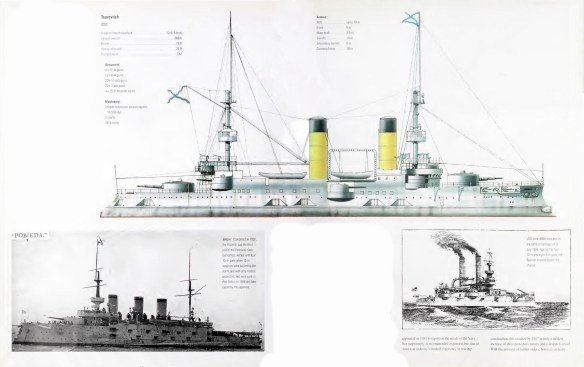Antoine-Jean Amable Lagane, director of the French shipyard Forges et Chantiers de la Mediterranee in La Seyne (Toulon), presented the Morskoi tekhnicheskii komitet [MTK] (Naval Technical Committee) with a design for a battleship based on the French Jaureguiberry was aided by the support of the Francophile Grand Duke Aleksei Aleksandrovich, brother of Tsar Aleksandr III and nominally head of the Imperial Navy. In July 1898 the Naval Ministry signed a contract with Lagane to build a 12,900-ton battleship in 42 months at a cost of 30.28 million francs (£1.47 million). Construction began on the Tsesarevich in May 1899 but like Cramp, Lagane failed to meet the schedule and the ship required 51 months to complete. The Tsesarevich had a high-forecastle hull with a curved tumblehome shape – the beam of the ship narrowed from the waterline to the upper deck, in order to reduce the weight of the upper deck – which French designers believed would allow greater freeboard and improved seaworthiness. The Tsesarevich also incorporated a 9.8-in-thick main belt of Krupp armor using Louis-Emile Bertin’s “cellular” approach to protection, which enhanced the ship’s ability to survive damage and remain afloat. The Belleville boilers that the MTK had insisted on proved far more reliable than Cramp’s Niclausse boilers and in trials the Tsesarevich achieved speeds at over 18 knots. In virtually every respect, the Tsesarevich was the best Russian battleship built prior to the Russo-Japanese War.
Tsesarevich was a pre-dreadnought battleship of the Imperial Russian Navy, built in France at the end of the 19th century. The ship’s design formed the basis of the Russian-built Borodino-class battleships. She was based at Port Arthur, northeast China, after entering service and fought in the Russo-Japanese War of 1904–1905. Tsesarevich was torpedoed during the surprise attack on Port Arthur and was repaired to become the flagship of Rear Admiral Wilgelm Vitgeft in the Battle of the Yellow Sea and was interned in Tsingtau after the battle.
After the war, the ship was transferred to the Baltic Fleet and helped to suppress the Sveaborg Rebellion in mid-1906. While on a Mediterranean cruise, her crew helped survivors of the 1908 Messina earthquake in Sicily. Tsesarevich was not very active during the early part of World War I and her bored sailors joined the general mutiny of the Baltic Fleet in early 1917. Now named Grazhdanin, the ship participated in the Battle of Moon Sound in 1917, during which she was lightly damaged. The ship seized by the Bolsheviks during the Russian Revolution in late 1917 and decommissioned the following year. Grazhdanin was scrapped in 1924–1925.
After the retirement of Bismarck in 1890, Germany cut Russia loose from its system of alliances; Russia and France, both friendless, immediately gravitated toward one another. The French navy visited Kronstadt in 1891, and the Russian navy reciprocated at Toulon in 1893, while the two countries signed a treaty of alliance and military convention in 1892 and 1894. Reflecting the diplomatic realignment, the Russian navy abandoned Krupp artillery for Schneider-Canet guns, the latter, like the former, produced in Russia under license. Eleven battleships laid down by 1895 completed the total of twenty prescribed in the fleet plan of 1882, but these included three 4,970-ton coastal battleships of the Admiral Ushakov class and the 8,880-ton second-class battleship Rostislav, along with seven respectable first-class battleships ranging in size from the 10,400-ton Sissoi Veliki to the first two vessels of the 12,680-ton Peresviet class. Armored cruisers included the 11,000-ton Rurik, obsolete by the time of its launch in 1895, and the more modern 13,675-ton Rossia (laid down 1894) and 13,220-ton Gromoboi (1897). Naval spending rose from £4.3 million in 1890 to £7 million in 1898, a year in which Russia’s Far Eastern ambitions prompted a new seven-year construction program, providing for another eight battleships, seventeen cruisers, and over fifty smaller vessels. Even though construction times for first-class battleships in Russian shipyards still averaged a respectable six years, the navy placed its first foreign orders for armored warships since the 1860s. The highly regarded 12,700-ton Retvisan, built by William Cramp of Philadelphia, was the first Russian battleship protected by Krupp armor. The 12,915-ton Tsesarevich, built in La Seyne, was used as a prototype for four warships of the 13,520-ton Borodino class. The Borodinos were built in Russian shipyards, along with a third ship of the Peresviet class and the 12,580-ton Potemkin. The eight battleships of the 1898 program all were in service by the beginning of the war with Japan in 1904. While focusing on capital ships Russia remained a leader in mine warfare, in 1898-99 constructing the world’s first purpose-built minelayers, the 3,010-ton Amur and Yenisei. Russia also purchased the submarine Protector, launched in 1902 by the American Simon Lake, built additional submarines in St Petersburg designed by Lake, and ordered three more from Germania of Kiel.
General characteristics |
|
|---|---|
| Type: | Pre-dreadnought battleship |
| Displacement: | 13,105 t (12,898 long tons) |
| Length: | 118.5 m (388 ft 9 in) |
| Beam: | 23.2 m (76 ft 1 in) |
| Draught: | 7.92 m (26 ft 0 in) |
| Installed power: |
|
| Propulsion: | 2 shafts, 2 Triple-expansion steam engines |
| Speed: | 18 knots (33 km/h; 21 mph) |
| Range: | 5,500 nmi (10,200 km; 6,300 mi) at 10 knots (19 km/h; 12 mph) |
| Complement: | 778–79 |
| Armament: |
|
| Armour: |
|
